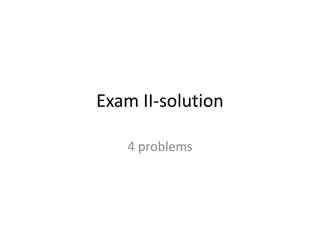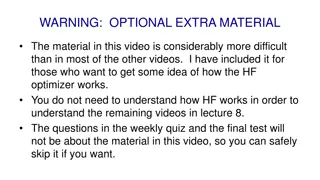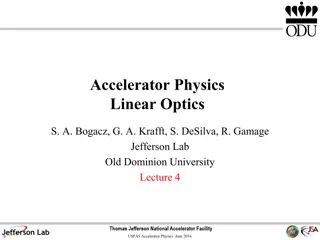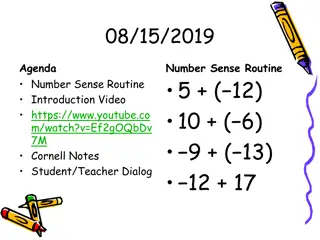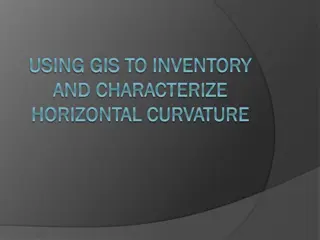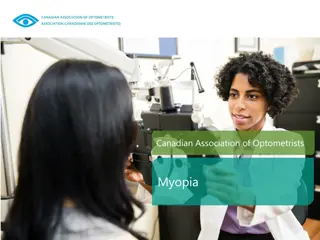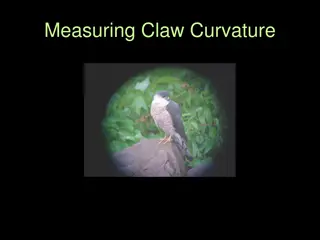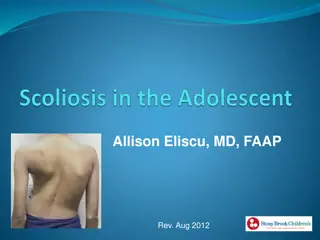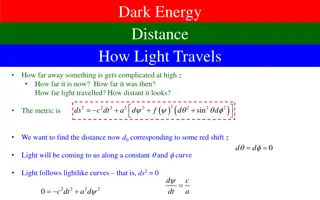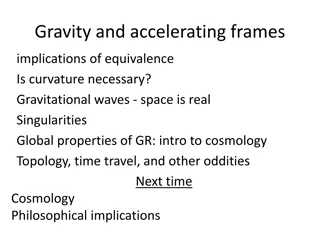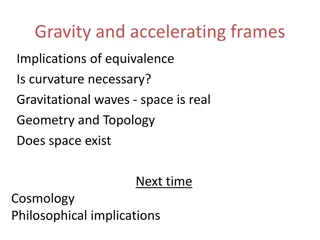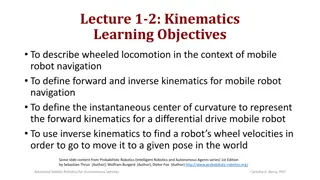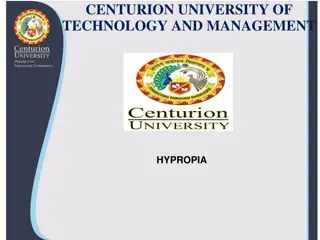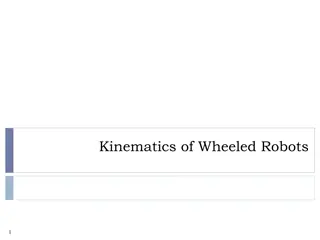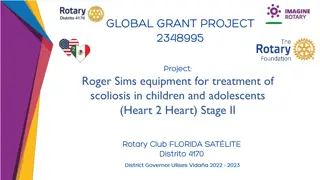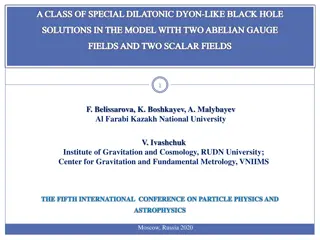Understanding Surfaces and Interfacial Energy in Chemistry
Surfaces play a crucial role in free energy and dissolution processes, impacting surface tension and interfacial energy. Learn about the adsorption of molecules, surface excess properties, and the contributions of surface area and curvature to surface energy. Dive into concepts such as Laplace's equ
6 views • 71 slides
Comparative Study of Abdominal Bones in Various Animals
Study of the abdominal bones in the ox highlights characteristics like elongated transverse and curved articular processes, whereas differences in horse bones include shorter bodies and varying curvature of transverse processes. Understanding these anatomical variances provides insights into the uni
0 views • 16 slides
Understanding Optical Telescope Types and Lens-Maker's Formula
Optical telescopes utilize lenses or mirrors to collect and focus light for imaging celestial objects. The lens-maker's formula is crucial for determining the focal length of lenses, considering factors like index of refraction and radii of curvature. Different lens configurations and materials help
0 views • 17 slides
Structural Engineering Solutions: Moments, Stresses, and Centroids
An in-depth analysis of structural engineering problems involving centroids, moments of inertia, maximum stresses, and curvature calculations. Solutions are provided for scenarios such as the application of couples to machine parts and wooden beams, determining maximum tensile and compressive stress
0 views • 12 slides
Optimization Methods: Understanding Gradient Descent and Second Order Techniques
This content delves into the concepts of gradient descent and second-order methods in optimization. Gradient descent is a first-order method utilizing the first-order Taylor expansion, while second-order methods consider the first three terms of the multivariate Taylor series. Second-order methods l
0 views • 44 slides
Understanding Hessian-Free Optimization in Neural Networks
A detailed exploration of Hessian-Free (HF) optimization method in neural networks, delving into concepts such as error reduction, gradient-to-curvature ratio, Newton's method, curvature matrices, and strategies for avoiding inverting large matrices. The content emphasizes the importance of directio
0 views • 31 slides
Exploring Hyperbolic Geometry and Tiling Patterns
Dive into the fascinating world of hyperbolic geometry, where angles in a triangle are less than 180 degrees and tilings exhibit negative curvature. Discover the beauty of the Hyperbolic Plane and learn about regular hyperbolic tilings characterized by Schlafli Symbols. Explore different models like
0 views • 46 slides
Linear Beam Optics and Particle Motion in Accelerator Physics
Explore the fundamental concepts of linear beam optics and particle motion in accelerator physics, covering topics such as design trajectory, path length, phase advance, transfer matrix, and more. Understand the intricacies of designing accelerators and the mathematical representations involved in o
0 views • 78 slides
Optical Alignment Using Beam Triangle Opti 521 Phil Scott
This presentation delves into the intricate process of optical alignment using a beam triangle, focusing on defining optical and mechanical axes, addressing alignment challenges, degrees of freedom for various elements, and the importance of setting up a beam triangle for accurate alignment. The con
0 views • 14 slides
Advancing Charged Particle Tracking Resolution in Particle Physics
Exploring the measurement of angle, curvature, and accuracy in charged particle tracking resolution within the CLAS Collaboration. The discussion delves into momentum resolution goals, ideal B-field alignment, and achieving 0.3% accuracy. Details on current momentum resolution, necessary steps for i
0 views • 19 slides
Understanding the Acceleration of the Universe and the Equivalence Principle Violation in the Horndeski Vector-Tensor Theory
Exploring the implications of the Equivalence Principle Violation after reheating in the context of the accelerated expansion of the universe. The study delves into the Horndeski vector-tensor theory, gravitational waves, and the impact of modified gravity and dark energy. Insights are provided on t
2 views • 20 slides
Understanding Number Sense: Squares, Square Roots, and Radicals
Explore the concepts of squares, square roots, and radicals through engaging examples, such as finding the distance to the horizon using the Earth's curvature formula. Understand the relationship between the area of a square and its side length, and discover the significance of the principal square
0 views • 33 slides
Automated Tool for Inventorying and Characterizing Horizontal Curvature in Roadways
Improving highway safety is a priority for transportation departments. This project aims to develop a tool that automates the identification and characterization of horizontal curves in roadway networks using GIS technology. Roadway curvature, including horizontal curves, plays a key role in predict
1 views • 26 slides
Understanding Myopia: Causes, Treatment, and Management
Myopia, also known as nearsightedness, is a common visual condition that affects a significant portion of the Canadian population. It is typically caused by elongated eyeballs or excessive corneal curvature, leading to blurry distance vision. While glasses or contact lenses can correct myopia optica
0 views • 15 slides
Mastering Claw Curvature Measurement Technique
Learn how to measure claw curvature using a step-by-step technique involving drawing chords, perpendicular lines, and measuring angles with a protractor. Practice the method on various bird claws such as Belted Kingfisher, Atlantic Puffin, Common Eider, Greater Black-backed Gull, and Great Blue Hero
0 views • 9 slides
Understanding Adolescent Idiopathic Scoliosis: Screening, Signs, and Management
Adolescent Idiopathic Scoliosis is a lateral curvature of the spine, affecting 2-4% of adolescents. Screening for scoliosis is important, with recommendations for annual checks by the AAP. Signs of scoliosis include asymmetry of shoulders, hips, and back creases. If scoliosis is detected, additional
0 views • 17 slides
Peyronie's Disease (Penile Curvature)
Peyronie\u2019s disease is also called as penile curvature disease that makes curved penis which causes anxiety, stress and pain during erection. For more info visit: \/\/ \/blog\/peyronies-disease-symptoms-causes-and-treatments\/
1 views • 10 slides
Understanding Dark Energy and Luminosity Distance in Cosmology
Exploring the concepts of dark energy, luminosity distance, and how light travels through the universe at varying distances and redshifts. The formula and implications of distance measurements using Hubble's Law and luminosity distances are discussed, along with the impact of matter presence, univer
0 views • 15 slides
Exploring the Implications of Gravity and Accelerating Frames in General Relativity
Delve into the fascinating world of General Relativity as we discuss the equivalence principle, gravitational waves, properties of spacetime, and the effects of curvature in the presence of gravity. Discover how Einstein's revolutionary theories have reshaped our understanding of the universe, leadi
0 views • 15 slides
Exploring Gravitational Effects and Space Curvature in Accelerating Frames
Explore the implications of equivalence in gravitational effects like redshift, time-warp, and space-warp in accelerating frames. Understand how the curvature of space is linked to non-uniform gravitational fields. Dive into observations confirming these phenomena, shedding light on the nature of sp
0 views • 30 slides
Understanding Mobile Robot Kinematics for Navigation
Exploring the kinematics of wheeled locomotion in mobile robots, this content covers forward and inverse kinematics, instantaneous center of curvature, and the use of kinematics for robot navigation. Highlighting the challenges of measuring robot position and the integration of wheel velocities for
0 views • 52 slides
Understanding Ametropia: Refractive Eye Conditions Explained
Ametropia refers to refractive errors in the eye such as myopia, hypermetropia, and astigmatism, where light rays don't focus correctly on the retina. This condition is influenced by corneal power, anterior chamber depth, crystalline lens power, and axial length. Hypermetropia, also known as hyperop
0 views • 25 slides
Understanding Kinematics of Wheeled Robots
Exploring the kinematics of wheeled robots, this content delves into the design and functionality of wheeled mobile robots, including the concept of ideal wheels, deviations from ideal conditions, and the importance of the Instantaneous Center of Curvature in enabling smooth rolling motion. It also
0 views • 37 slides
Treatment of Scoliosis in Children and Adolescents - Heart 2 Heart Program
Scoliosis, a condition causing sideways curvature of the spine, can lead to severe complications. The Heart 2 Heart Program aims to support low-income children and adolescents with scoliosis, providing orthopedic corsets, specialized wheelchairs, and advanced surgical aids for better outcomes. The i
0 views • 7 slides
Special Dilatonic Dyon-Like Black Hole Solutions in Two-Field Model
A class of special dilatonic dyon-like black hole solutions in a model with two Abelian gauge fields and two scalar fields is explored. Motivation for the study includes dimensional reduction of supergravity models and manifestations of dark matter. The solutions involve black hole dyon solutions, a
0 views • 12 slides



